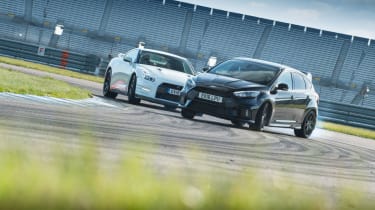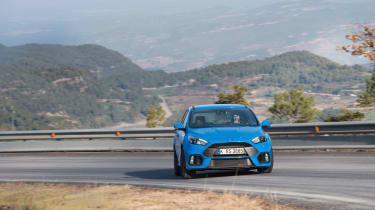Ford Focus RS review – ride and handling
The Focus RS impresses with strong performance and great handling
The Focus RS is certainly a firm car. On UK roads it’s probably just on the cusp of being too stiff. The ride is fidgety at low speeds, however above 50mph or so it starts to smooth out anything but the most severe bumps.
When the road becomes more demanding, and the bumps become crests that can really upset a car, the Focus maintains supreme control. The body remains well supported in compressions, and never seems to get close to bottoming out. Large undulations, that could confuse the body and cause it to become out of sync with the road, are dealt with quickly and effectively.
If you fancy trying the firmer dampers on the road, then a button at the end of the left hand stalk will allow you to make them 40% stiffer without you having to put the car into full track mode. But it doesn’t take long for you to realise that they are far too firm, and vertical inputs are transmitted into the car and don't improve the RS's compsure.
The RS has very quick steering that feels very sensitive to even minor inputs. The sometimes-bumpy ride does mean that, as you’re jolted around the cabin, you can inadvertently add steering inputs you don’t want to. This means on rough roads you constantly have to correct the steering.
But the hyper-active steering works brilliantly with the front-end. There’s plenty of bite, especially if you trail brake a little, and the front responds immediately. This pointy front end endows the RS with a naturally neutral to oversteer balance on corner entry. It behaves very much like an aggressively set-up front wheel drive hot hatch, and can use a throttle lift to agitate the rear end.
More reviews
Group tests
In-depth reviews
- Used Ford Focus ST (Mk4, 2019-2025) review – Ford has killed its last remaining hot hatch
- Ford Focus ST review – engine, gearbox and technical specs
Reviews
- ZeroNine Ford Focus ST review – Ferrari 599 pulling power in a hatchback
- Used Ford Focus ST Edition (Mk4, 2021 - 2025) review – a Honda Civic Type R rival for £20k
- Ford Focus 2025 review – is Ford killing its best car?
- Used Ford Focus RS500 (Mk2, 2010 - 2011): review, specs and buying guide for the original hyperhatch
The chassis allows some roll, but it’s very controlled and acts more of a barometer for how much grip the Michelin Pilot Super Sports have in reserve. It’s most useful mid-corner, as it allows you to judge when to get on the throttle.
The rear end of the Focus can be persuaded to step out more easily on a wet road. However in the dry, if you’re aggressive on turn in and then on the power early, the rear will trace a greater arc than the front. It does require a lot of commitment and a well-sighted corner, though.
If you aren’t as committed at the start of a bend, and you try to induce some oversteer just on the exit in the dry, nothing really materialises. There is a sense of an exaggerated yaw movement, that even with more throttle sadly never turns into oversteer. This is the only time the Focus RS ever feels contrived. But considering the control the systems have over the car, that’s mightly impressive. In the wet, and over much bumpier terrain, the rear finds less grip and breaks away more naturally.
Be smooth with your inputs and the RS will carry huge speed through a corner. If you haven’t unsettled the rear, there are times where it feels like the drivetrain is fighting with the tyres. There’s a sense it’s almost tearing itself apart and it can create a pulsing, bouncing movement throughout the car.
If what you really want is some lairy, sideways action – and you’re within the safe confines of a circuit or closed road – then you can experiment with the Focus’s Drift Mode. When selected, the GKN 4WD system sends a large proportion of the available torque to the outside rear wheel to induce a slide. The driver has to apply a lot of throttle so there’s enough torque to overcome the trye’s grip. So far, much like trying to get a rear-wheel drive car sideways but it’s once the Focus has started to slide that it begins to feel unique to the RS. The rear differential manages the torque between the rear wheels to maintain the angle of the slide, all the driver has to do is keep their foot pinned and point the front wheels where they want to go.
It sounds like a lot of fun, and to some extent it is. However if you’re used to the way a rear-wheel drive car looses grip under power, performing a slide with Drift Mode on takes some getting used to – instead of backing off the throttle slightly to regain some control, maintaining full throttle doesn’t feel very natural. The lack of interaction needed to pull-off a clean, competent slide robs you of some of the satisfaction but it's undoubtedly fun, if a little childish.
With the Focus in Track mode, with the traction and stability control fully turned off, it will still perform power-on oversteer. It isn’t quite so easy to provoke, but the result feels similar to that of Drift Mode just not quite so easy to sustain a long slide. Neither mode makes the RS feel like a proper rear-wheel drive car, but no other 4WD car offers this level of riotous playfulness.
There’s no doubt the RS is an extremely effective and fast car. There’s a real quality to the way it rides and how cohesive the package feels; the steering, rate of roll and drivetrain have been engineered to perfectly complement each other. But unlike many of its competitors, of which their talents only stretch as far as being effective, the Focus is adjustable, fun and makes for a very entertaining, involving drive.





